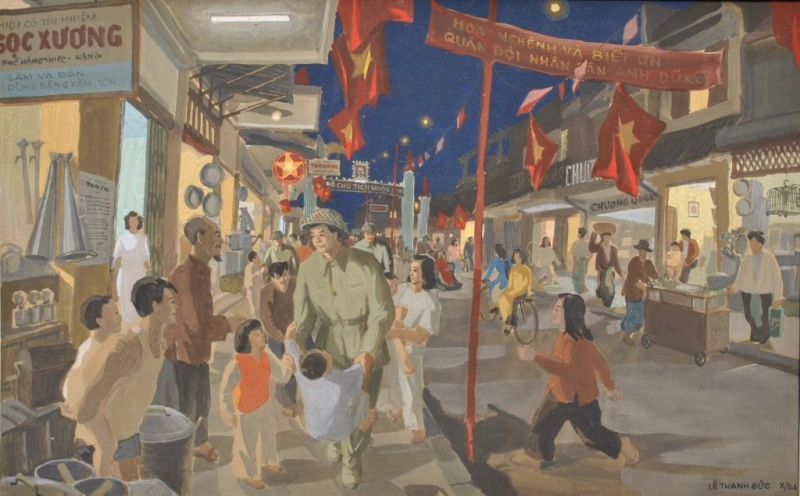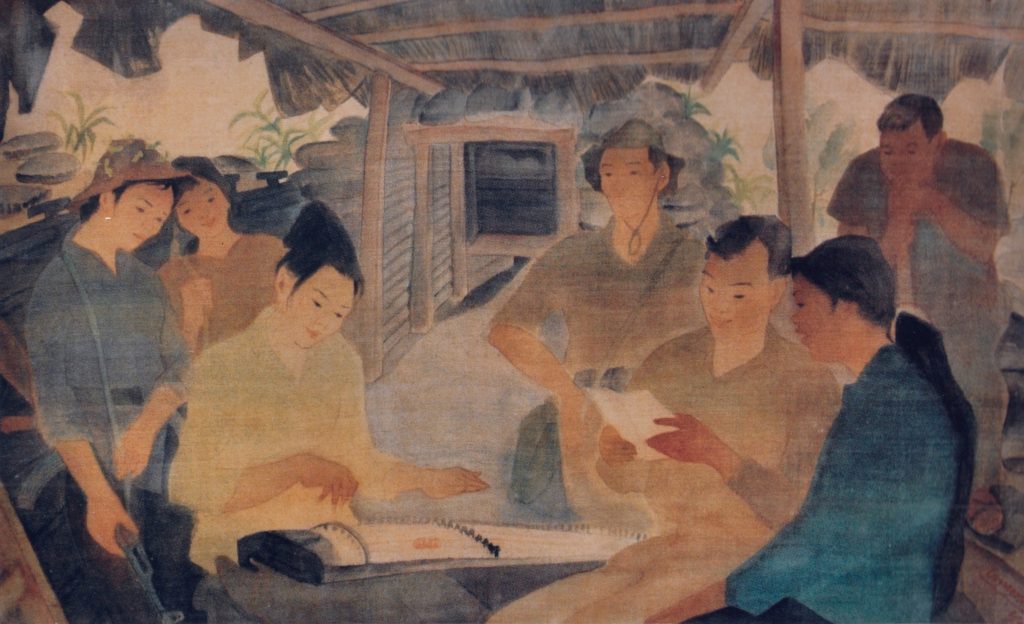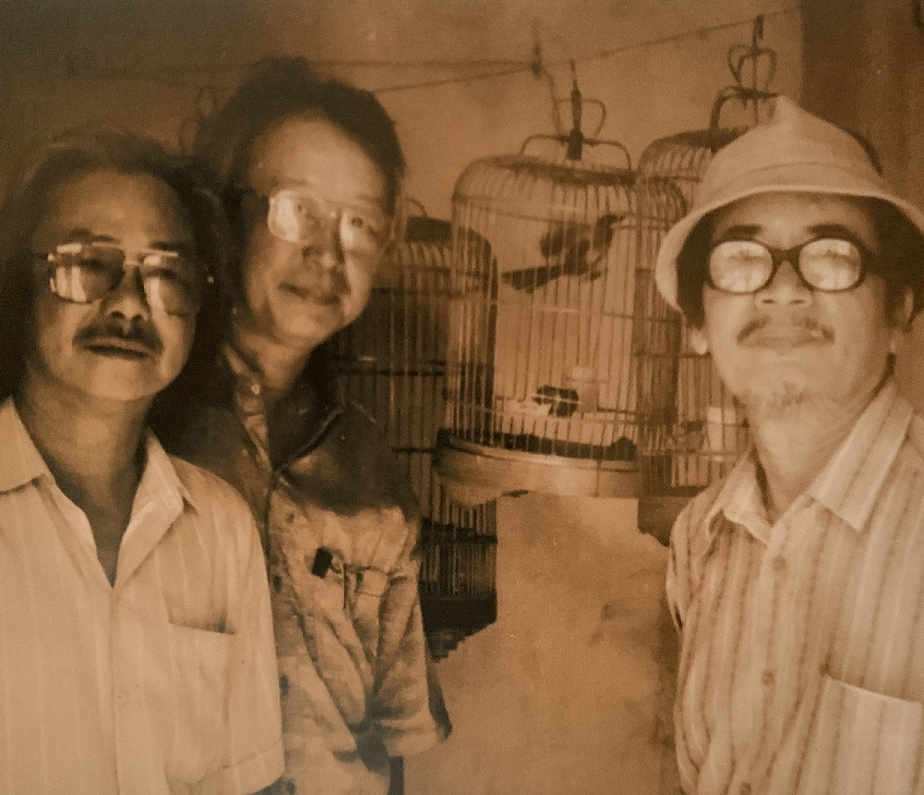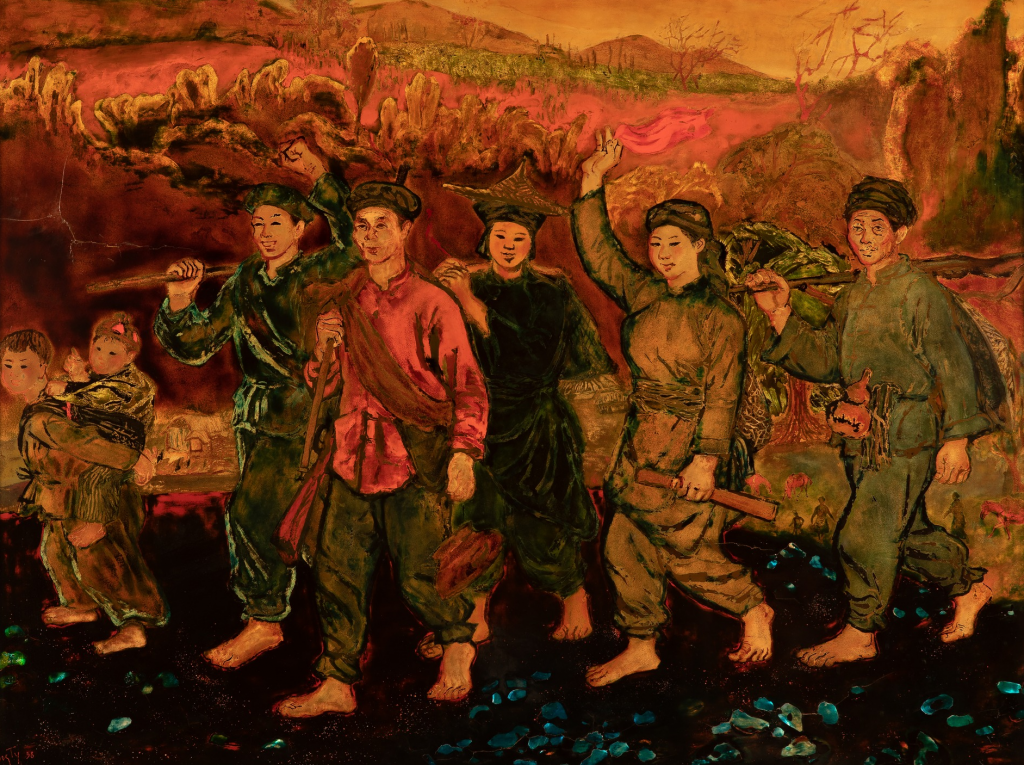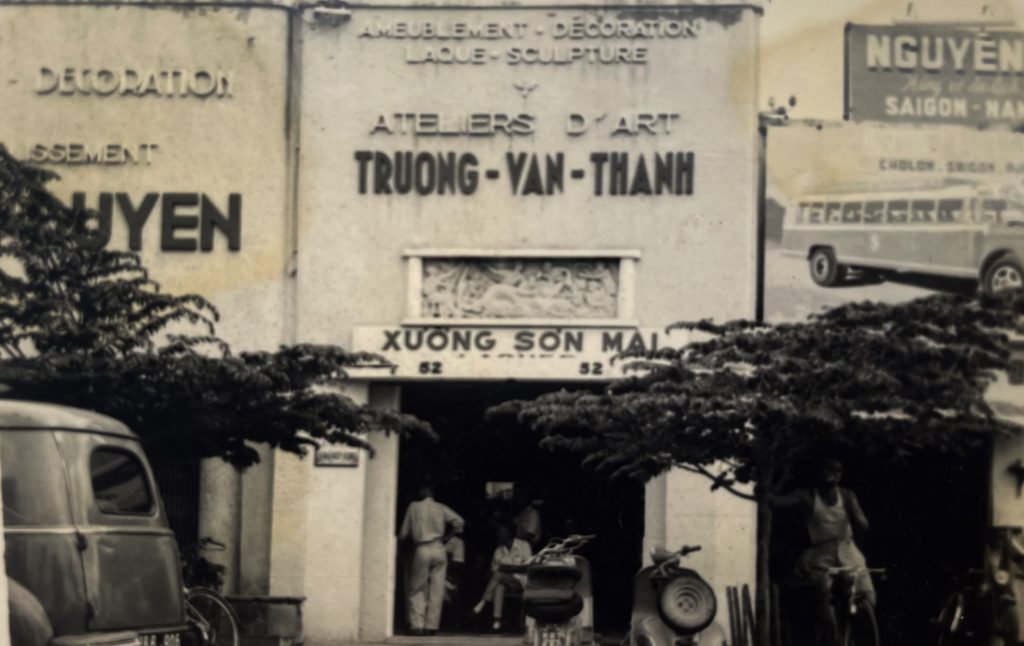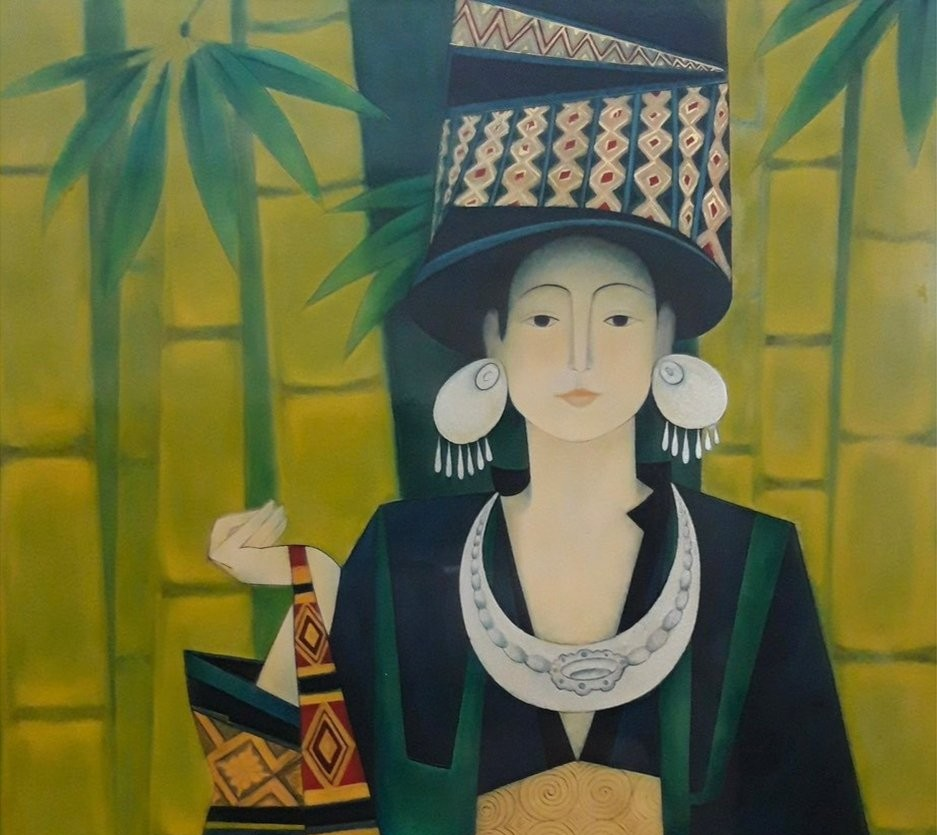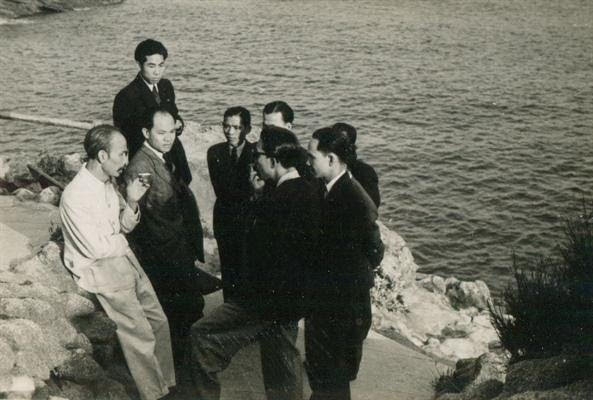
President Hồ Chí Minh and members of his entourage and overseas Vietnamese delegates.
Photo taken on June 13, 1946 (Painter Mai Trung Thứ wearing dark glasses) – Collected photo.
On the occasion of the 115th birth anniversary of artist Mai Trung Thứ, Nhân Dân Newspaper published on Wednesday, November 10, 2021 the article “A heart for Việt Nam homeland” about the contributions of artist Mai Trung Thứ, who preserved and contributed to the Vietnamese Revolution valuable documents about Việt Nam’s history during the Hồ Chí Minh era in the early years of the country’s founding. Painter Mai Trung Thứ (1906-1980), patriotic figure, overseas Vietnamese in France was both a great painter, a predecessor of Vietnamese modern fine arts, a cinematographer, an intellectual, a great artist whose heart had always been towards the homeland. In the spring of the year of Tiger 1974, he was invited by Việt Nam government to visit the homeland along with a number of patriotic Vietnamese artists and intellectuals.
Returning after 38 years
One day at the end of 1973, my mother – who called artist Mai Trung Thứ as uncle – announced to us, her children, that her uncle Mai Thứ (artist Mai Trung Thứ’s common name) would return to visit homeland during Tết Giáp Dần 1974 [the lunar new year of 1974, the year of Tiger] and one of the addresses he would visit was our home. We were very, very happy because for a long time we only knew him through the stories of our mother and relatives. At that time, there was no internet, so access to his works and articles written about him was limited. We just knew that he had made significant contributions to the country, so the Government invited him to visit the homeland just in time of Tết.
Going to Gia Lâm airport to welcome the group that year, in addition to the authorities, there were also writers and artists, including writer Mai Ngữ, who calls artist Mai Trung Thứ as uncle. According to people’s accounts, when he set foot on his homeland, the gray-haired Vietnamese artist could not contain his emotions and shed tears. My mother was waiting to see him at the Dân Chủ Hotel, Tràng Tiền Street. My mother immediately recognized her uncle even though when he left the homeland, she was just a little girl. When they met, they were so happy and emotional. He held my mother’s hand and said he would come to visit our family, but he still had to go with the group. At that time, having a group of overseas Vietnamese visitors was unprecedented. Therefore, the schedule, activities, destinations of the group and each member must be approved, and the arrangement time was very tight.
In addition to the activities of visiting and meeting with the group, artist Mai Trung Thứ was also arranged to return to his grandparents’ hometown, to light incense to show gratitude to his ancestors; visiting his teachers, meeting friends and students the time he was a teacher in Huế. In Hà Nội, artist Mai Trung Thứ visited and wished a happy new year to his two sisters on Hàng Bông street. According to relatives, that meeting took place in an emotional and warm atmosphere of family. Having lived away from family for 38 years was not a short time. When he moved out of the country, his sisters were two young ladies, and when he came back, his sisters were at the age that their eyes were blurry and their legs are slow. Painter Mai Trung Thứ is one of the few sons in a family with daughters, so right from his childhood, he lived in the love of his family, especially his sisters. When they met again, he could still live in that love and even more so because in addition to his sisters, there were a lot of children in his big family.
He came to my mother’s home – his niece welcomed him – on a winter morning, warm and clear in Hà Nội. My mother’s relative sisters and brothers had gathered in the room. Everyone introduced members of their own families. He listened very attentively. My first impression of him was that he was a very stylish and handsome person. He was tall and big, with flowing hair and looked very artistic. His outfit was polite but open-minded, different from the men of that time who only had official outfit, very serious. He exuded simplicity, friendliness, a gentle smile mixed with a bit of humor, just like my uncles. The meeting was short because of his busy schedule. He got going sadly because the appointment for the next meeting was still so far. Now, looking at the photos capturing those warm moments of reunion, I am still overcome with emotion because I will never be able to meet artist Mai Trung Thứ the second time and forever.
Fatherland, homeland, the artist
Artist Mai Trung Thứ was born in 1906 in An Dương, Hải Phòng, in a family of academics who worked as mandarins during the feudal period. His father, Mr. Mai Trung Cát, worked as a mandarin to the position of governor, and was awarded the title of Thái tử Thiếu bảo [the highest official of the Nguyễn Dynasty] Đông các Đại học sĩ [The great scholar], one of The four greatest officials of the court. In the Nguyễn Dynasty, The four greatest officials is considered The four great scholars, four high official positions of Việt Nam feudal period.
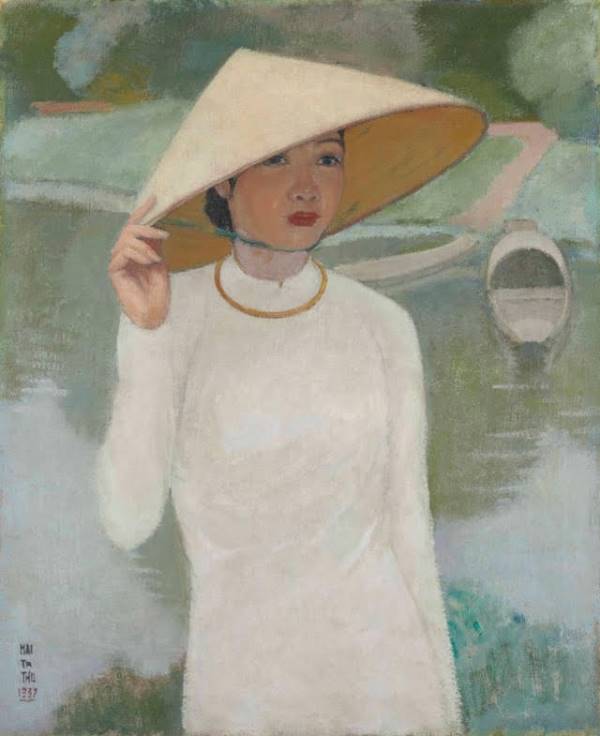
Mai Trung Thứ (1906-1980), “A girl of Huế”, 1937, Oil on canvas, 73 × 60,5 cm.
According to the predecessors of the family, painter Mai Trung Thứ’s father, Mr. Mai Trung Cát, despite of his high position, was gentle and elegant. He was close to his children and grandchildren, he cared about his family, relatives and the homeland. In particular, he always attached great importance to educating his children and grandchildren and instructed family members to live ethically and with virtuous hearts. He also has a reputation as an honest mandarin who prioritized benevolence and usefulness for the people. Children, grandchildren and family members keep looking at his example and following. Although influenced by the rules and regulations of the feudal regime, he was very advanced in establishing order in the family and respecting the legitimate interests of his children and grandchildren. Thanks to that thought, his beloved son Mai Trung Thứ was supported by his father in realizing his wish to become an artist right from the first decades of the twentieth century.
Painter Mai Trung Thứ did not grow up following the official path like his father. He entered the first class of Indochina Fine Arts College, at the same time like painters Nguyễn Phan Chánh, Lê Văn Đệ, Lê Phổ, Nguyễn Cao Luyện. This is the fine arts school Indochina, with a French pedagogue and progressive intellectual as principal. He is also one of the few artists who graduated from the first class of this reputable school.
The name of artist Mai Trung Thứ is associated with famous silk paintings on the subjects of women, children and daily life. According to experts, artist Mai Trung Thứ is the one who has greatly contributed to the color development of silk paintings. His color palette returns to flat, clear, quiet areas like the Vietnamese soul, which longs for peace and clarity. That is the image of innocent, cheerful children playing, attentively and diligently learning to write, embroider, or obedient and trusting in their grandmother’s and mother’s arms; scenes of happy reunion between generations in the family or scenes of intimate conversations between friends, sisters. It is also the image of graceful, dreamy young women writing poetry while admiring the scenery, noble, elegant, gentle ladies… All exist on the silk background, through talented drawings and the artist’s soul. All of these have made the works of artist Mai Trung Thứ exude a delicate, gentle beauty, rich in poetry, rich in Asian quality and imbued with Vietnamese soul.
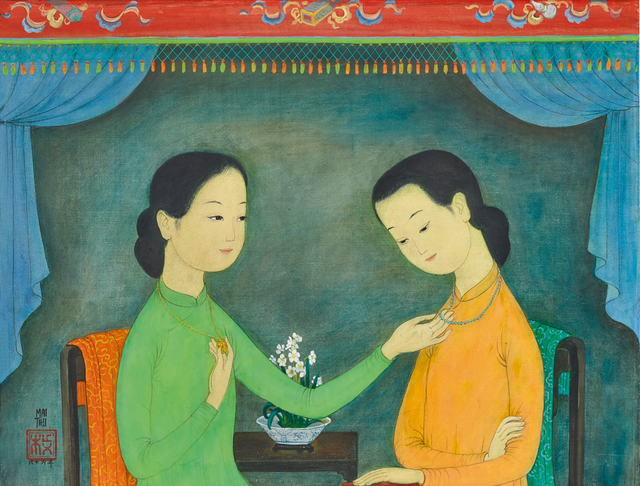
Mai Trung Thứ (1906 – 1980). Coquetry. 1966. Ink and colour on silk, 45,5×59,5 cm
During my mother’s lifetime, she used to talk about the life of the big family in the residence of Mr. Mai Trung Cát – father of artist Mai Trung Thứ. He had daughters and grandchildren living under the same roof. Every time artist Mai Trung Thứ returned to visit his family, the whole family was very happy. The children, who called the artist as uncle, were all around the age of ten, and were prepared with decent clothes and hair to welcome him. The sisters gracefully went back and forth, preparing tea and drink to welcome their younger brother. It was a harmonious, cozy family atmosphere. My mother also said that every time he came home, the children were both happy and nervous. Happy because he told them to play around freely, but nervous because they would have to model for him to draw. When seeing the pictures her uncle drew, my mother was very moved. Because these paintings remind her of old scenes when my mother and everyone lived with her grandparents.
My uncle lived with his uncle (painter Mai Trung Thứ) for years in Huế, in a villa on top of Bến Ngự slope. He said, the quiet, peaceful, contemplative, ancient life of Huế with the gentle, graceful girls with voices like the breeze attracted the talented and romantic artist. In addition to teaching sessions at Quốc Học Huế [National School of Huế], artist Mai Trung Thứ was passionate about his creative emotions. He still remembers, at that time, he was assigned by the artist to enlarge his sketch of Chàm women dancing to later serve as a model for a relief on the wall of the Chàm Ancient Institute in Tourane (Đà Nẵng). At artist Mai Trung Thứ’s studio, my uncle also took the opportunity to admire at the paintings hanging on the wall or unfinished on the easel.
Particularly impressive was the painting of a young woman in a purple áo dài with her smooth hands gliding over the keys of a zither, an innocent, graceful beauty like the figures of Đồng Khánh schoolgirls on after-school time. During this time, my uncle also met the artist’s model, a beautiful girl of Huế who was a good player of instrument, charming, whom the boys desired, especially writers and artists. Later, that girl became the wife of a famous poet of Vietnamese poetry in the thirties of the last century. It is said that during his return visit to the country, artist Mai Trung Thứ met the beauty in the painting and the person of his dreams again at a meeting of a group of overseas Vietnamese artists with domestic writers and artists.
When choosing France as where he settled, the artist’s luggage is not only his works but also precious experiences and warm memories of life and people in his homeland. Memories always stayed in the thoughts and emotions of the artist in a different country, causing him to bring life into the silk and the colors, and then they became masterpieces, contain the fragrance to these day.
Right in the heart of the capital of light, the cradle of culture, art and architecture, where trends and quintessence of art converge, silk paintings by artist Mai Trung Thứ are still one of the highlights of exhibitions as well as auctions. One of his paintings has set a record for Vietnamese fine arts on auction floors abroad. People know and appreciate a modern, very unique Vietnamese art, not influenced or mixed, partly because of the works of this talented, modest artist.
When talking about artist Mai Trung Thứ, we also talk about a heart that always looked towards the homeland and the country. Just like his father, if he could do anything useful for the people or the country, he did not hesitate to devote his whole heart and soul. In addition to painting, artist Mai Trung Thứ was also a professional cinematographer, he had a film studio and produced his own films. In 1945, hearing the news that the country was carrying out the August Revolution, overseas Vietnamese in France excitedly organized activities to support the Vietnamese revolution and support the Hồ Chí Minh Government. Artist Mai Trung Thứ with a video camera recorded all the events of patriotic overseas Vietnamese and made it into a documentary titled “Vitality of 25,000 overseas Vietnamese in France”, produced by himself. The film was sent home by him immediately after and was widely shown in Hà Nội, making people in the country feel more empowered and more confident in the nation’s revolution.
In 1946, President Hồ Chí Minh set out to visit the French Republic at the invitation of the French government. This was an important foreign policy activity of the Vietnamese government in protecting the country’s peace. As a cinematographer, artist Mai Trung Thứ was honored to join the Vietnamese delegation. He recorded all the images and activities of President Hồ Chí Minh during those historic days in France and some activities of the Vietnamese delegation at the Fontainebleau Conference at that time. Recently, the article “A heart for Việt Nam homeland” – Nhân Dân Newspaper published on Wednesday, November 10, 2021, on the occasion of the 115th birth anniversary of artist Mai Trung Thứ, commented: “The images in the film honestly recounts the process of dialogue and negotiation to protect the independence and unity of Việt Nam by peaceful means of President Hồ Chí Minh through documentary language, very new and strange in the country at that time.” During his lifetime, journalist Hồng Hà – former editor-in-chief of Nhân Dân Newspaper – who went to France to meet artist Mai Trung Thứ in 1974 also recalled that all of those precious documents were donated to the country by the artist, including nearly one hundred kilogram of 35mm film and 11 tapes recording Uncle Hồ’s voice during his visit to France.
This is also the basis for domestic filmmakers to produce the movie “Nguyễn Ái Quốc – Hồ Chí Minh”. The film was screened on September 2, 1975 in the capital Hà Nội and Sài Gòn city. For the first time, the people of two major cities saw the scene of President Hồ Chí Minh reading the Declaration of Independence at Ba Đình Square on September 2, 1945 and his activities in France in 1946.
The heart for the homeland, the spirit of righteousness, and the sense of kindness are precious traditions of a family that artist Mai Trung Thứ and his family members have absorbed, preserved, and shined. The great letter hanging in the worship hall of the family that his father was given, with the words “Quang Tiền Dụ Hậu”, roughly translated as “Make the past generation proud, set a shining example for the future generation” is a symbol of the wisdom of the family, is the consciousness and reason for living of their descendants.
During the two holy wars of resistance to protect the country, the artist’s relatives sacrificed their lives for the nation’s independence and freedom from the first days of independence in 1945 on Cô Tô island, in the advancing Southern army 1952 in Đà Nẵng and on the fierce Central Highlands battlefield in the 70s of last century. One of the artist’s sisters was honored by the State posthumously with the noble title of Vietnamese Heroic Mother. Artist Mai Trung Thứ also had relatives who have become famous and have successful careers, contributing to the country in fields such as writer Mai Ngữ, professor, PhD, Vietnamese researcher; author Nguyễn Khắc Hoạch (Vietnamese American); veteran military journalist Nguyễn Khắc Tiếp, painter Lưu Yên, famous violinists such as artist Khắc Văn, Meritorious Artist Khắc Huề, mathematician – silver medal in math international competition in 1976, Dr. Nguyễn Thị Thiều Hoa…
In particular, artist Mai Trung Thứ had only one daughter, veterinarian Mai Lan Phương. During his lifetime, he really wanted his daughter to return to contribute to the country. Before the covid pandemic broke out, Ms. Mai Phương still returned to visit her hometown and meet relatives. According to her father’s will, at one time, she returned to Việt Nam to work for the organization Veterinarians without borders to support our farmers in preventing diseases in livestock during her two-year term.
When he visited the Fatherland 48 years ago, artist Mai Trung Thứ promised to return to help and advise the domestic fine arts industry in producing and exporting goods to Europe, but that idea has not yet come to fruition. In 1980, after a very successful exhibition, artist Mai Trung Thứ’s heart stopped beating due to a sudden heart attack, and he died at the age of 75. His body was buried at the foot of a mountain near the capital Paris.
In 1985, an uncle of mine on a business trip to France came to visit him. His notes said that it was a late autumn morning, Paris was chilly, Vanves cemetery, where he rested, was idyllic and quiet. His tomb was covered with pink marble, above was engraved with the solemn and respectful words: ARTISTE MAI THU (1906-1980). Nearly forty years after artist Mai Trung Thứ passed away, according to his and his family’s wishes, the entire family were very moved to have the late artist’s remains brought back to the homeland. He rested in the mausoleum complex of Mr. Mai Trung Cát, his respected father.
Recognized and honored
The trip back to homeland in the spring of 1974 at the invitation of the Vietnamese Government left artist Mai Trung Thứ with deep impressions of the warm of the government, agencies, organizations, relatives, friends and colleagues, former students. His contributions were highly appreciated in speeches and stories with respect and admiration. The students whom he taught at National School of Huế also gathered with him. Everyone respectfully called him teacher as before, even though at that time they were all people with important positions and very famous in literature as well as in the political field. During the lifetime of my father-in-law, a veteran revolutionary officer and a former student at National School of Huế, he was very moved when he heard me tell the story of the return to the Fatherland of painter Mai Trung Thứ. My father spoke about Teacher Thứ with respect and regret because he could not meet his talented and friendly teacher again with his friends because during those years my father-in-law was still in the Southern battlefield.
The late painter and cinematographer Mai Trung Thứ was posthumously awarded a Certificate of Merit from the Prime Minister of the Socialist Republic of Việt Nam. This is a correct recognition by our State of his valuable contributions as well as his love and respect for the Fatherland and Leader Hồ Chí Minh. In 2013, the People’s Council of Hải Phòng City decided to name Mai Trung Thứ Street in Hải An District, Hải Phòng City. The tomb complex of Văn Tân Tử Mai Trung Cát is also expected to be recognized by the city government as a historical monument.
In July 2021, at the Ursulines Museum, Mâcon city, France, to celebrate the 115th birthday of the late painter Mai Trung Thứ, a large-scale exhibition called “Mai Thứ – The echo from a Việt Nam in dream” took place. According to domestic and foreign media, the exhibition with 140 works summarizes the life and career of a famous painter – an international social and artistic activist. The exhibition “Mai Thứ – The echo from a Việt Nam in dream” not only affirms the talent and intelligence of Vietnamese people but is also an opportunity to promote Vietnamese culture and spirit to a large international public.
A lifetime of creativity and dedication to art and the country with a clear soul and warm heart, nearly half a century of living away from the Fatherland, this 2022 Year of the Tiger is the third new year, the late artist Mai Trung Thứ rests in peace in his ancestral homeland, in the love and respect of his family, homeland, and country – the place created, nurtured, and contributed to shine a talent, a personality – Artist Mai Trung Thứ.
Đà Nẵng, when the spring of 2022, year of Tiger, is coming
N.L.H
Written by author Mai Liên Hương, posted on the Đà Nẵng Literature General Online Information Page
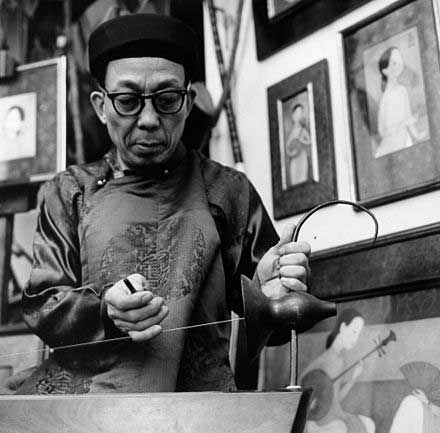
Mai Trung Thứ playing the monochord (1968)
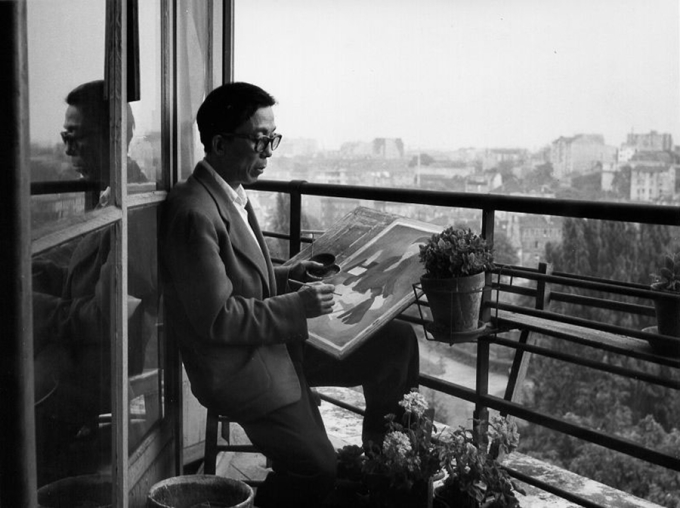
Mai Trung Thứ drawing on the balcony of his apartment in Vanves
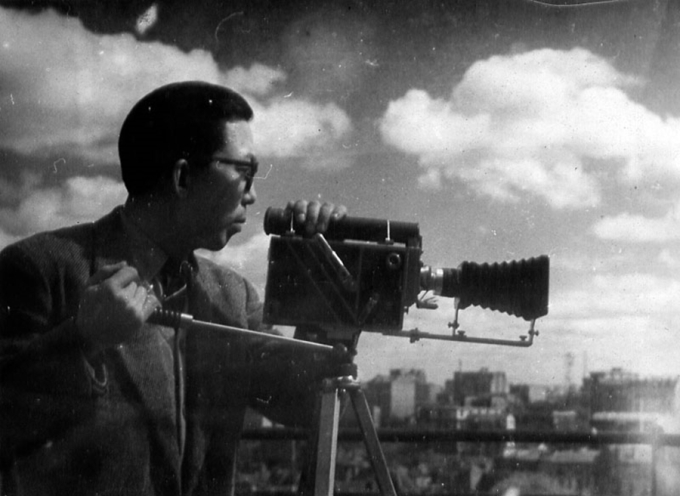
Mai Trung Thứ filming during President Hồ Chí Minh’s visit to Paris, France in 1946.
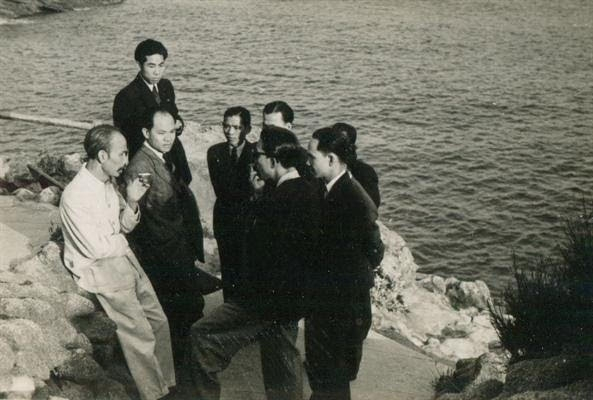
President Hồ Chí Minh and members of his entourage and overseas Vietnamese delegates.
Photo taken on June 13, 1946 (Painter Mai Trung Thứ wearing dark glasses) – Collected photo.
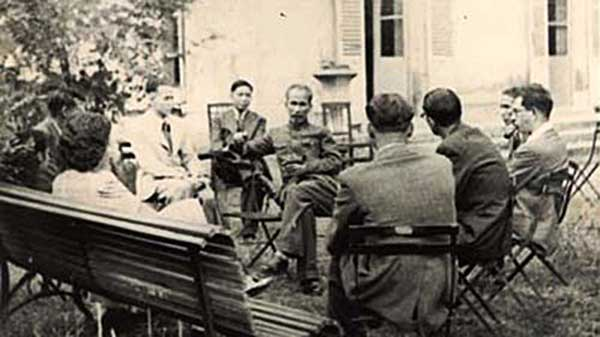
Image of Uncle Hồ talking to French democratic youth in Paris, 1946,
saved by artist Mai Trung Thứ
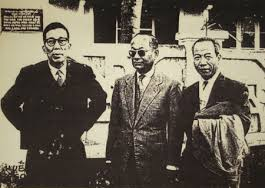
Mai Trung Thứ with Viễn Đệ
and Tôn Thất Đào in Huế


